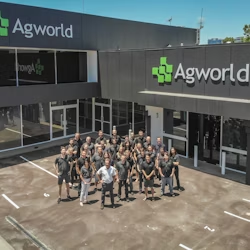With the Christmas holidays over and 2019 in full swing, most of us will have had some time to reflect on 2018 and on what we think 2019 might have in store for us personally and for agriculture in general. During this break I managed to catch up with a number of friends that work in agriculture, both in Australia and overseas, and asked them what their thoughts were. Aside from talking about the obvious topics such as commodity prices, weather and certain macro-economic factors, we often ended up talking about price vs service focus that is becoming visible in agriculture around the world.
In 2018 we saw lots of news about how the agricultural inputs supply chain might be changing and how ‘amazonification’ is going to cause major disruptions. As I used to work for an ag retail organisation in Australia and still work with many ag retail organisations from around the world in my current job, I find it interesting to continually look at the potential merits of ‘Amazonification’ being a major disruptor in agriculture.
Disrupting Ag Retail
One of the main factors to keep in mind when looking at potential disruptions in ag retail is how disruptions usually work: they tend to completely overhaul an industry, or even make incumbent actors obsolete, all in a very short period of time. Good examples of this are:
- Uber and other ridesharing apps rapidly changing the taxi industry;
- Netflix and others making stores like Blockbuster obsolete, seemingly overnight;
What was the real cause of the disruption here? Was it the disruptors by offering new services, or the incumbent organisations by not moving with their time? Taxi organisations in most cities did not offer any app-based booking services and you’d often be left waiting for hours for a taxi only to get into a dirty car with a grumpy driver. Blockbuster did not offer movies online, but only offered movies on DVD’s and other physical media, which created the inconvenience of having to go to a shop without knowing whether your preferred movie was available and if you returned a movie an hour late, you’d be charged late fees. These organizations did not move with general technological advancements seen in society and are now struggling to compete or have disappeared completely.

Got what it takes to join the Agworld team? We’re looking for talented individuals to help us deliver innovative solutions in agriculture.
Keeping this general pattern of disruption of industries in mind, existing ag retail would therefore need to be completely devoid of moving trends such as technological advancement etc. in order to create the space for a disruptor to move in. Is this what we are seeing? I personally don’t think so.
Sure, some might have become a little complacent or not have shown enough value to their growers and have therefore encouraged online, price-focused players to emerge. On the other hand, I see many ag retailers and co-ops globally offering new and innovative concepts to improve the service offering available to their clients and I know many farmers that are excited to see what additional services their local retailer can offer to help them improve their yield and bottom line.

Commodity vs service
So what about this ‘Amazonification’ that we are seeing? Why is it happening and what are its merits? In 5-to 10-years’ time, with the benefit of hindsight, we will be able to tell how this trend developed, but I think we can already start to look at the key fundamentals. Disruptions tend to be most successful in industries and products that can easily be commoditized, e.g. – you want a taxi driver to deliver you to your destination or you want your entertainment provider to have your favourite movie available when and where you need it. These providers do not need a high degree of knowledge about your business, you are most likely not looking to build a 20-year partnership with them and can easily replace them with another provider if need be.
So that leaves the big question: can ag retail be commoditized? There will be many different opinions about this, (and I’m already looking forward to all the e-mails and opinions I’ll get after publishing) but I don’t think it will be commoditised. I still see the relationship that ag retailers and co-ops have with their clients as very important and not something that growers are willing to forego just to be able to save a few dollars on seed, chemical or fertilizer.
I think the watch out for ag retail as an industry is to keep updating their business model and the way they operate to counter the threat of becoming a ‘lift-and-shift business’, a model that depends on price and efficiency that will inevitably lose to someone out there that is better at that model cheaper. Research has shown that digital ag offers ag retailers opportunities for new business models when they focus on value-based service, and digital ag is therefore well positioned to help ag retailers and co-ops counter the threat of ‘amazonification’.
Service is still key
In my opinion, service has always been key in agriculture and this will not change soon. With tighter margins, growers are now, more than ever, looking for a risk-and-reward sharing partner that helps them achieve success. Those ag retailers that offer new services, novel approaches to help their growers increase their profits and that are with them through good and bad times, are the businesses that will thrive.
Sure, having platforms and businesses that loudly advertise prices on chemicals, fertilizers and the like will pressure local retailers to become more competitive in certain aspects as there is a maximum premium that most growers are willing to pay for their local partner. But this pressure is manageable and there are plenty of ways available to generate new, service-based, revenue streams and other ways to remain relevant to growers.

Winners and losers
Key for ag retailers will be to choose the game they want to play, and set the rules through being agile and transparent: offering their growers a healthy mix of products and services that help them achieve success. Those that change their offering to try and compete with ‘amazonification’ by lowering their prices are helping their competition by commoditizing their own offering and are now playing someone else’s game that is hard to win.
And who stands to gain from changing ag retail from a service focused business to a commodity-focused industry that has no local presence and that offers no added value or extra services? Sure, whoever owns the online trading business will win and do well. The big factor to consider though is, whatever it might seem like from a distance, growers surely won’t be the winners in a scenario where they can only procure low-price inputs without access to specialized and localized services. And a situation where growers aren’t winners, isn’t sustainable.
So, my argument: it’s all about value based service as perceived by the grower. And I think that digital ag can play a big role here for both retailers and growers. Growers are obviously interested in adopting digital ag, albeit at varying levels, but many express the need to get guided on their ‘digital ag journey’, and no-one is better positioned to be this guide than ag retailers or co-ops. If these organisations focus on offering services in the digital ag sphere with a high degree of service, they can make themselves indispensable to growers.
Ag retailers and co-ops will have to keep focusing on the relationship with their growers though and make sure they remain relevant in a changing landscape. They already have a head-start by employing local people, sponsoring local sports teams and having knowledge of your growers’ operation. As long as these retailers and co-ops keep focusing on their own strengths, instead of on something that a disruptor will inevitably be better at, they will survive and thrive together with their growers.





